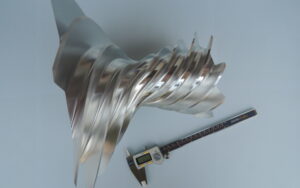One remarkable element of infuse printing innovation is the full-shading capacities. When printing 2D pictures from advanced records, PCs convert the RGB esteems (red, green, and blue tones showed on the screen) to CMYK tones (cyan, red, yellow, and dark).
Normally, a 2D shading work area printer will have a print head with three of the shading channels, CMY, and another for dark, K. Utilizing these four inks, the printer consolidates a few spots in each printed pixel however the utilization of requested vacillate examples to make the presence of thousands of shadings. A similar rule applies to 3D printing. Z Corporation’s 3D printers utilize four hued folios, cyan, fuchsia, yellow, and dark, to print tones onto the shell of the part. The product imparts shading data to the printer inside the cut information.
Clients can likewise utilize shading to speak to investigation results straightforwardly on the model or to explain and name configuration changes to additional improve the correspondence estimation of the model as appeared in plastic prototypes suppliers china.
While shading can be a fundamental specialized instrument, numerous 3D programming bundles don’t give a basic method to deliver 3D documents that incorporate shading information. To address this test, ZEdit programming, a Microsoft Windows – based program encourages the expansion of shading information to 3D part records. ZEdit is an apparatus for part shading, markup, naming, and surface planning. Clients additionally use it to plan .jpeg records onto 3D part geomet ries.
Inject printing innovation printers produce almost no waste. The unprinted powder encompasses and underpins complex parts during printing. Clients can reuse all unused help powder. Subsequently, printed-part volume turns into the reason for all part-creation costs. The utilization of an off-the-rack print head by china 3d prototyping manufacturers takes into account modest, fast substitution of the framework’s essential consuma ble segment. The utilization of secluded plan strategies to the printer’s hardware, printing, and support parts makes the printers effective to keep up with least personal time, further decreasing expenses.
A comparative cycle, direct shell creation projecting (DSPC), is a patternless projecting cycle for metal parts in which the projecting molds are produced naturally, straightforwardly from 3D CAD information. With DSPC there is no requirement for physical examples, center boxes or some other tooling, and no part-explicit arrangement. The main example is simply the CAD plan. Another comparable cycle, ProMetal innovation, once in the past possessed by Extrude Hone, is a use of MIT’s 3DP cycle to the manufacture of infusion molds. ExOne Company was shaped by turning out a few dissimilar advances from Extrude Hone in 2005.
Direct shell creation projecting is marginally not quite the same as the frameworks like SGC or SLA in that a hole is delivered to the components of the CAD model required. The shell is inherent an earthenware permitting the immediate creation of venture shells from CAD information.
A CAD record is utilized by rapid prototyping service manufacturers china to characterize the necessary pit, and the framework changes this document to suit the speculation projecting cycle by presenting filets and eliminating machined highlights, for example, openings. The quantity of castings required is then gone into the PC controlling the framework and the model of the shell created.
As appeared in rapid plastic prototype china, this cycle is like 3D printing. A layer of alumina powder is set down onto a round and hollow bed. A print fly tasks a fine stream of colloidal silica in the necessary arrangement of the cut onto the powder covering. This hardens and furthermore holds fast to the past layer. When the cut of shell has been drawn, the machine bed brings down and the cycle is rehashed until the whole shell has been shaped. Likewise with the 3D printing measure, the overabundance powder goes about as a help while the shell is being delivered. On finishing the shell is eliminated from the canister and abundance powder is taken out from inside the depression.
After a shape is printed, it is terminated to make an unbending clay form. One can empty any liquid metal into these molds, in this manner disposing of a few stages needed in venture projecting. Additionally, these molds are more precise than those from standard sand projecting. Resiliences for lengths more modest than 1 in. are +0.021 in; for lengths more prominent than 6 in., exactness is +0.031 in addition to 0.003 in./in. more than 6 in.
